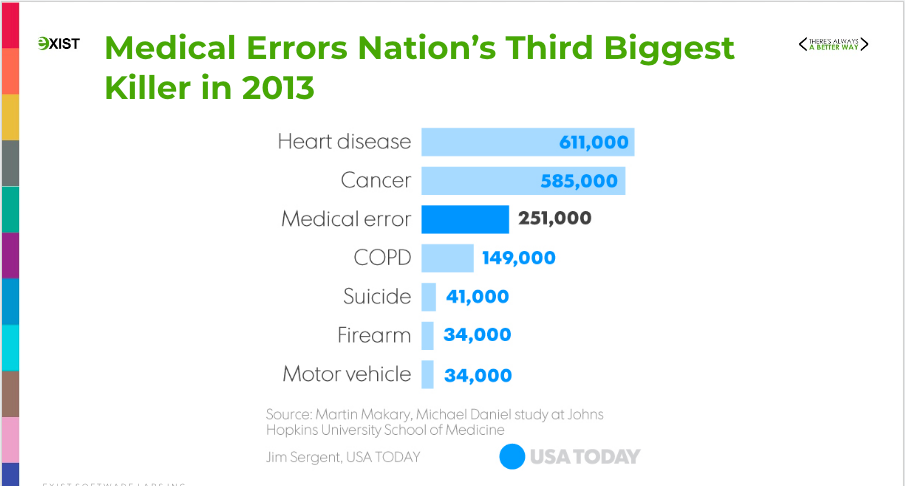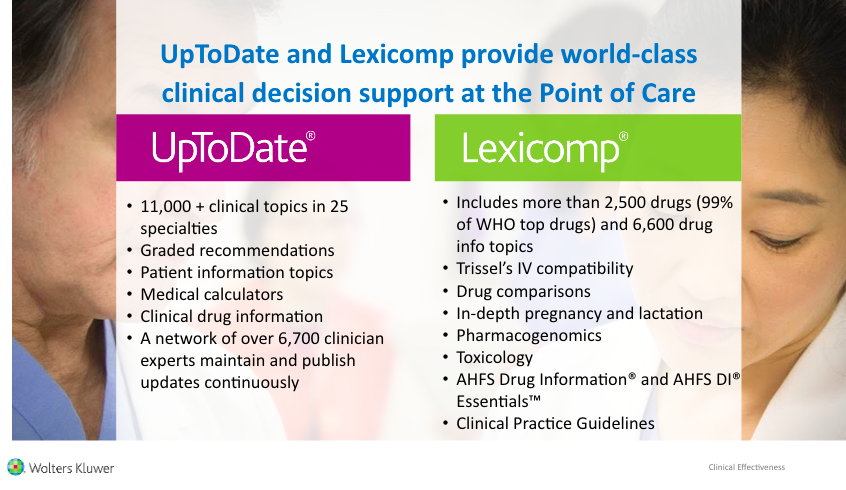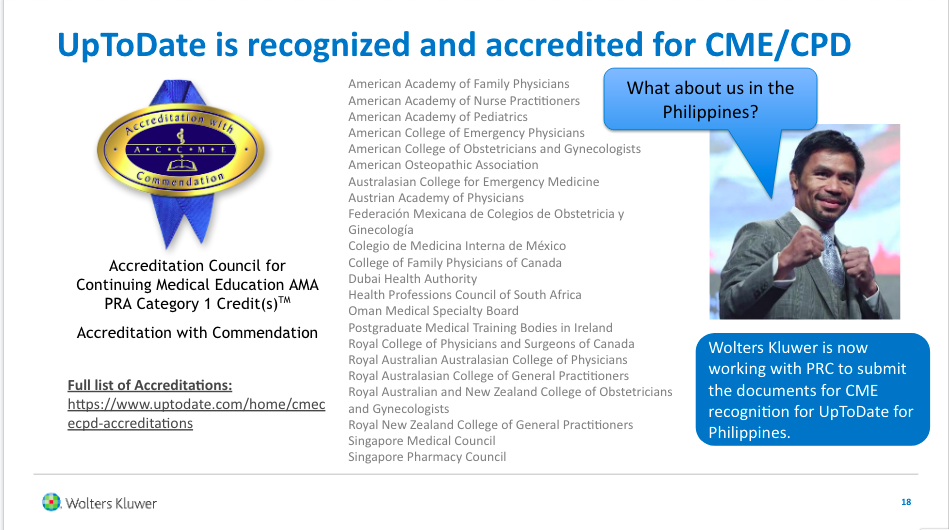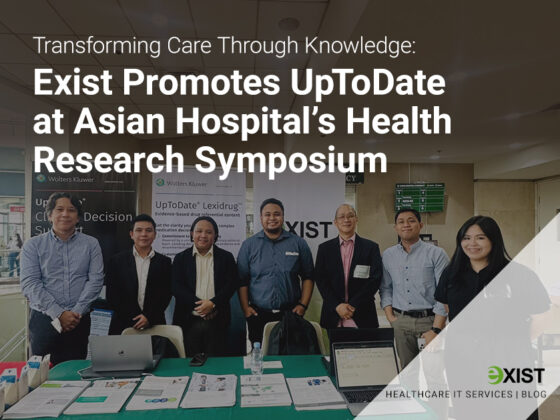Speaker 1: Mr. Willex Perez | Exist Vice President for Sales & Marketing; Director of Healthcare Solutions
Our current situation right now is like the rug pulled under our feet. We were forced to transform, and ultimately, change how we will be doing things moving forward.
This can be related to two buzz words we may have been hearing for about 3-5 years already.
The term “Digital Transformation” is felt (more pronounced this time as the use of digital platforms has become ubiquitous. We have heard about this term, but what does it really mean for the organizations that we belong to, and what are the challenges that they encounter?
Digital is not just a computer and a network connection. While it is true that computers enable us to adjust to this situation, “digital” really means:
-
-
- The ability to take physical work by a person at a place, and be able to take it to a virtually
-
-
-
- Automating the work to be done by anyone or anything (machine) anywhere. These services are given to the clients to address their needs while providing better convenience and customer experience
-
Transformation, on the other hand, is predominantly used in Economics and Sociology as this is people-driven. It touches the very infrastructure and the people surrounding it from each socio-economic class. Transformation or change involves people, businesses, and organizations as well as the workforce and the customers, bringing change into new ways of how we conduct our work into our lives using digital platforms.
The biggest challenge for organizations in implementing a digital strategy is providing leadership—a leadership team that understands and is ready to face the challenge. While a lot of resources are being poured towards this transformation, many are failing. A winning team needs to keep its eye on where the ball will be and not where it has been. The question that you may ask is: Are you investing in the future or are you still working on what you currently need? But Technology is only as an enabler. To wield its great potential, great leadership is needed to get the most out of new opportunities it brings, and avoid the dangers that come along with it.
Here are some examples of adoptions of digital solutions that we may, or may not, be aware of, either by force or by choice:
Like mobile Banking, for example, which we take for granted.
Our banking experience is way different compared with that of the previous generation. To transact nowadays, we need not go to a physical bank. Banks will do well to target clients, not just by managing their physical branch but improving their online services which impact how they maintain their presence as well as managing their operational expenses.
Entertainment is enjoying the greatest hit of all industries at the moment with leading providers distributing their multimedia content globally online through streaming platforms such as Netflix.
With the threat of infection, education is now forced to shift online, too.
Our days begin and end consuming news and information online from our preferred digital platforms. But with the prevalence of fake news nowadays, we are careful about our sources of information and realize how important it is to do fact-checking.
Doctors like yourselves face the same dilemma. As you may observe, doctors (especially clinicians) need a reliable resource to help them as they are always pressed for time to diagnose and treat patients.
Why is your source — for the latest evidence-based medical information to update your medical knowledge and answer your clinical questions important?
The importance of getting reliable information affects the high occurrence of medical errors. This ability to get hold of evidence-based information helps in assisting the doctors at the point of care. When a clinician experiences fatigue and information overload in making a clinical decision.

This study highlights that medical error is the 3rd biggest killer in the United States.
Yet in 2019, medical errors are about as prevalent as in 1999. “To Err Is Human” was an uneasy read; so is a September 2019 report on patient safety from the World Health Organization.
Among WHO’s findings:
-
-
- Globally, hospital-acquired infections afflict about 10% of hospitalized patients.
- Medical errors harm some 40% of patients in primary and outpatient care.
- Diagnostic and medication errors hurt millions and cost billions of dollars every year.
-
– TIME BY KATHLEEN SUTCLIFFE NOVEMBER 5, 2019
Things haven’t changed much. Medical errors harm 40% of patients in primary and outpatient care.
The good news is this handling this error are:
-
-
- It is preventable
- There are tools and digital platforms available, such as UpToDate, wherein information is
-
-
-
-
-
-
- Evidence-based
- Updated regularly by a team of over 6,000 doctors
- Comes with Graded recommendations
-
-
-
-
-
-
- Affordable to countries in Asia, especially in the Philippines wherein UpToDate is already being used by numerous clients
-
UpToDate is the best online resource being used by over 34,000 medical institutions and hospitals with over 1.3 Million doctors across the world. Evidence shows that UpToDate is proven to result in better hospital performance and improve patient outcomes.
Speaker 2: Ms. Amanda Tay | Partner Business Lead, ASEAN Region at Wolters Kluwer Clinical Effectiveness
How we can help and support your institution in delivering the best clinical decisions support resources to enable you to improve patient outcomes as well as improve patients’ safety?
There are studies that support the idea that patients only receive about half of the recommended processes involved in care. This is due to imperfect information flow, different skill sets across the organization, patients who are able to determine what type of treatments they would like to go after as well, and of course inefficiencies and inconsistencies in the approaches that they take, which is apparent in the current day context.
But this also translates into prescribing errors according to this issue of BMJ Quality & Safety. This study shows that 43 million adverse drug events related to medication errors, drug screening misses, or else occur each year around the globe. It’s very appalling to think about what’s the impact on patient outcomes then.
With all these inconsistencies and unwanted variability in care, up to 30% of global healthcare spend is wasted on unnecessary costs on healthcare annually and that’s about $1,700 per person each year.
With all of these evolving things that are happening around the world, are we in the right position to tackle such unwanted challenges?
Wolters Kluwer’s healthcare team has already started working with their editorial team, making sure that our support allows our frontline healthcare community to be well equipped to handle and tackle challenges like this pandemic.
In January, Wolters Kluwer already released their first COVID19 topic. From then on, there have been countless contributions to the creation of new topics as the pandemic develops.
As they deem this very important, they provided free UpToDate access for two (2) months in March to support the frontline users and non-users, allowing them to access to clinical decision support resources during this sensitive time.
Since January, all the way to July, they consistently contributing evidence-based clinical contents, making sure that it’s credible and well supported. These contents are immediately available to users which is important in providing assistance to healthcare providers in tackling their uncertainties during their in-depth journey. As of now, there are over 500 updates regarding COVID19 topics alone.
UpToDate became the predominant resource when it comes to COVID19, with millions of views of their topics that have been recorded since the spike of cases.
To tackle unwanted variability in care, the improvement in patient outcomes is determined by the quality of care team decisions, and how it aligns across teams. It is also dependent on the care team behavior, and care team alignment.
When you look at care team behavior, you’ll think of doctors with varying experiences, and different team members with different temperaments and personalities. Would they use software to support their clinical decision making? This also determines how efficient they make decisions, and how accurate it is, and they pass it on to their care team in the pharmacy department to proceed with the drug orders, to the patient ward, and others. It is not a one-man effort. It is across various departments.
How do you put everything together to ensure that you are leaning on a consistent, evidence-based resource? At every step at every point in a patient’s journey, you have to make a decision. That is why it is very important to have evidence-based content that is very credible. It is important to think about what other resources can you consider to ensure that you are well supported with an integrated playbook.
Imagine having that across every step of the journey, with different types of tools and resources that play different parts in supporting your care team.
UpToDate is a global leader for evidence-based clinical decision support. It is now upgraded to support physicians by having interactive pathways that can help them in the decision-making process. Laboratory interpretations feature were also added to help the physicians assessing the software to understand the types of scenarios that might occur.
Lexicomp, on the other hand, is a drug referential resource, with a huge drug database that is accessible for the users, which can certainly reduce medication errors as well using the tools available in it. Thousands of hospitals and retail pharmacies lean on Lexicomp as the key drug resource.
What could UpToDate and Lexicomp offer?

UpToDate and Lexicomp provide the ability to go into complex cases and go into recommendations. It is graded, thus signifies that it is supported with evidence-based, and unbiased and neutral clinical studies. These two build up a network of thousands of clinician experts, pharmacists, specialists, and more all actively contributing to the contents of these two applications. They are the ones who will help you scour through all journals and clinical studies to provide the synthesized and summarized content so that you don’t need to read every single resource which will save you some time, especially at the point of care.
UpToDate and Lexicomp provide harmonized care decisions throughout a patient’s journey. Information is easily accessible to users at each department. It ties everything together. The whole clinical healthcare team across all the departments are able to lean on a synthesized and integrated playbook, a single source of truth that can support all departments. They get consistent information and have a good discussion with each other through these two.
Japan did a retrospective study across hundreds of diagnostic reports prepared by doctors against a group that did not use UpToDate versus a group that uses UpToDate. What they found was extraordinary in that for those using UpToDate, the diagnostic error was 2%, as compared to a 24% diagnostic error for those who were not. Imagine the impact on the patients who could have benefitted if the doctors referred to UpToDate, ensuring that not many medication errors occur.
In a recent Hospital Insights Asia interview with Asian Hospital’s Dr. Ana Maria Jimenez, she stated that by using UpToDate for two (2) years, there has been a decreasing trend in their ICU mortality ratio.
Meanwhile, The Medical City’s Dr. Rafael S. Claudio said that UpToDate is comprehensive and authoritative with an extensive list of clinical topics available that is easy to use for its simple interface. This supported his physician team on their journey to treat patients.
Also, Wolters Kluwer’s Clinical Information Drug Surveys show that the impact of Lexicomp is definitely broad and overwhelmingly positive.
Another consideration that you might have is if it is recognized/accredited.
 See full list of accreditations.
See full list of accreditations.
It is understandable that training and education is one of the key areas that healthcare institutions focus on. How do you make sure that everyone is well-equipped, and is continuously upskilled? That is why you should consider what other resources are available to support you on this journey. With our efforts to get UpToDate recognized in PRC, we offer continued professional development support.
In summary, these solutions that we offer provide:
-
-
- A harmonized approach to help you support and improve your quality of care.
- Reduce diagnostic and medication errors to help you treat your patients fast
- Quicker and more efficient flow to shorten their length of stay so that you can help more patients
- Improve patient education and engagement
-
Check out our healthcare product, MEDCURIAL, and see how it helped some of the biggest hospitals in the country provide better patient outcomes.




